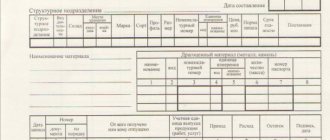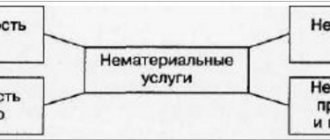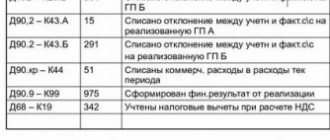Accounting for goods receipt
Goods are inventories purchased from other parties and intended for sale in the ordinary course of business without additional processing (clause 3 of FSBU 5/2019).
Since 2021, the accounting of goods is regulated by the new FSBU 5/2019 “Inventories”. The new procedure for accounting for goods is discussed in detail in the Ready-made solution from ConsultantPlus. Trial access to the system can be obtained for free.
Receipt of inventory items is reflected in the debit of account 41 in correspondence with mutual settlement accounts: 60, 71, 75, 86, etc. (chart of accounts approved by order of the Ministry of Finance dated October 31, 2000 No. 94n).
Goods are accepted for accounting at actual cost (clause 9 of FSBU 5/2019), which includes all costs incurred during the acquisition of goods and materials, including (clause 11 of FSBU 5/2019):
- payment for goods to the supplier;
- costs of procurement and delivery of goods to the place of their sale;
- pre-sale preparation costs (sorting, packaging, etc.);
- other expenses.
Accounting for goods in wholesale and retail trade has some differences. Companies that sell goods wholesale record them at cost of acquisition. Retail companies are given the right to choose to record the cost of inventory items: either at the purchase price or at the sales price, with separate consideration of markups and discounts (clause 21 of FSBU 5/2019). The selected accounting option must be secured as an element of the enterprise's accounting policy.
Read more about how to account for goods in wholesale and retail trade in ConsultantPlus. Get trial access to the system for free and go to the Typical situation.
Let's look at the main transactions when goods arrive.
| Wholesale | Retail | Content | ||
| Dt | CT | Dt | CT | |
| 41 | 60 | 41 | 60 | Goods received from supplier |
| 19 | 60 | 19 | 60 | VAT allocated |
| 41 | 60 | 41 | 60 | Related expenses reflected |
| 19 | 60 | 19 | 60 | VAT allocated on related expenses |
| 41 | 42 | Markup reflected | ||
Analytical accounting of account 41 is organized in the context of warehouses, financially responsible persons, names of inventory items, etc.
An example of accounting for trade margins from K+ An organization purchased for retail sale: 500 kg of carrots at a price of 10 rubles/kg. Trade margin 50%, i.e. 2,500 rub. (10 rub/kg x 500 kg x 50%); 300 kg of apples at a price of 30 rubles/kg. Trade margin 150%, i.e. 13,500 rub. (30 rub/kg x 300 kg x 150%). During the month, 100 kg of carrots were sold at 15 rubles/kg (10 rubles/kg + 10 rubles/kg x 50%) and 30 kg of apples at 75 rubles/kg (30 rubles/kg + 30 rubles/kg x 150%). Revenue - 3,750 rubles. (15 RUR/kg x 100 kg + 75 RUR/kg x 30 kg). There is no natural loss or other disposal of goods other than sales. We calculate the average markup percentage. You can view the calculation in K+ by getting free trial access.
GLAVBUKH-INFO
Accounting for the presence and movement of inventory items purchased as goods for sale is carried out on active account 41 “Goods”.This account is used mainly by organizations engaged in trading activities, as well as organizations providing public catering services.
This account is independently used in cases where goods purchased for resale are valued at their purchase price (the cost of their acquisition).
Sub-accounts can be opened for account 41 “Goods”:
- 41–1 “Goods in warehouses”;
- 41–2 “Goods in retail trade”;
- 41–3 “Containers under goods and empty”;
- 41–4 “Purchased products”, etc.
Subaccount 41–1 “Goods in warehouses” takes into account the availability and movement of goods located at wholesale and distribution bases, warehouses, storerooms of organizations, etc.
Subaccount 41–2 “Goods in retail trade” takes into account the availability and movement of goods located in organizations engaged in retail trade (in shops, tents, stalls, kiosks, etc.) and in buffets of organizations engaged in public catering.
The same sub-account takes into account the presence and movement of glassware (bottles, cans, etc.) in organizations engaged in retail trade and in buffets of organizations providing catering services.
Subaccount 41–3 “Containers under goods and empty” takes into account the presence and movement of containers under goods and empty containers (except for glassware in organizations engaged in retail trade and in buffets of organizations providing catering services).
In subaccount 41–4 “Purchased items,” organizations engaged in industrial and other production activities using account 41 “Goods” take into account the availability and movement of goods (in relation to the procedure provided for accounting for inventories).
Acceptance for accounting of goods and containers that arrived at the warehouse is reflected in the debit of account 41 “Goods” in correspondence with account 60 “Settlements with suppliers and contractors” at the cost of their acquisition.
When an organization engaged in retail trade records goods at sales prices, simultaneously with this entry, an entry is made in the debit of account 41 “Goods” and the credit of account 42 “Trade margin” for the difference between the acquisition cost and the cost at sales prices (discounts, markups).
Transport costs and other expenses for the procurement and delivery of goods are charged from the credit of account 60 “Settlements with suppliers and contractors” to the debit of account 44 “Sales expenses”.
When using accounting prices, the receipt of goods is reflected using account 15 “Procurement and acquisition of material assets” in a manner similar to the procedure for accounting for corresponding transactions with materials.
Goods transferred for processing to other organizations are not written off from account 41 “Goods”, but are accounted for separately.
Goods accepted for safekeeping are accounted for in off-balance sheet account 002 “Inventory assets accepted for safekeeping.” Goods accepted for commission are accounted for in off-balance sheet account 004 “Goods accepted for commission.”
Analytical accounting for account 41 “Goods” is carried out by responsible persons, names (grades, lots, bales), and, if necessary, by storage locations of goods.
Tax aspects. In accordance with Art. 170 of the Tax Code of the Russian Federation, VAT amounts presented to the organization (VAT payer) when purchasing goods on the territory of the Russian Federation or actually paid by the organization when importing goods into the customs territory of the Russian Federation are not included in the organization’s expenses taken into account when calculating income tax.
In other words, VAT is not included in the cost of purchased goods and in their accounting prices, unless otherwise provided by law. In this case, the VAT amount must be highlighted as a separate line in invoices received from suppliers.
VAT imposed by suppliers of goods is taken into account on account 19 “Value added tax on acquired assets” (subaccount 19–3 “Value added tax on acquired inventories”) simultaneously with the acceptance of received goods for accounting.
Subject to the conditions established by Ch. 21 of the Tax Code of the Russian Federation, the organization that purchases the goods can subsequently present the amount of VAT billed by the supplier for deduction.
As a rule, deductions of VAT amounts presented to the organization upon purchase or paid when importing goods into the customs territory of the Russian Federation are made after they are accepted for registration and in the presence of correctly executed primary documents, including invoices.
In addition, deductions of the specified amounts of VAT are made provided that the goods are intended for subsequent sale.
Amounts of VAT subject to tax deduction are written off from the credit of account 19 “Value added tax on acquired assets” (subaccount 19–3 “Value added tax on acquired inventories”), as a rule, to the debit of account 68 “Calculations for taxes and fees" (subaccount 68-1 "Calculations for value added tax").
In case of violation of the above conditions, the amounts of VAT paid when purchasing goods are taken into account in the cost of their acquisition.
In particular, when the primary accounting documents (invoices, invoices, invoices, cash receipt orders, certificates of completion of work, etc.) confirming the cost of purchased goods do not indicate the amount of VAT, then the settlement documents (orders, demands-orders) , registers of checks and registers for receiving funds from a letter of credit) its calculation is not carried out by calculation. The cost of goods purchased in such cases, including the estimated VAT on them, is taken into account as a whole in the goods account.
In addition, VAT amounts presented to the buyer when purchasing goods or actually paid when importing goods into the territory of the Russian Federation are taken into account in the cost of such goods in the following cases:
- acquisition (import) of goods used for operations for the production and/or sale of goods (work, services) that are not subject to taxation (exempt from taxation);
- acquisition (import) of goods used for operations for the production and/or sale of goods (work, services), the place of sale of which is not recognized as the territory of the Russian Federation;
- acquisition (import) of goods by persons who are not taxpayers of value added tax or who are exempt from fulfilling the taxpayer’s obligations for the calculation and payment of tax;
- acquisition (import) of goods for the production and/or sale of goods (work, services), sales operations of which are not recognized as sales of goods (work, services) in accordance with clause 2 of Art. 146 of the Tax Code of the Russian Federation.
With regard to income tax, it should be noted that on January 1, 2005, amendments to Art. 318 and 320 of the Tax Code of the Russian Federation, which changed the procedure for determining the purchase price of goods purchased for the purpose of their further resale.
For profit tax purposes, organizations that purchase goods have the right to choose whether to take into account any costs associated with the purchase of goods (except for the costs of delivering purchased goods to the buyer’s warehouse, if they are not included in the price of goods) in the purchase price of goods or take them into account as costs circulation (selling expenses).
In Art. 320 of the Tax Code of the Russian Federation, similar to the accounting rules, stipulates that in tax accounting, transportation costs for the delivery of goods when determining the purchase price of goods can be taken into account either in the cost of purchasing goods or as part of distribution costs (selling expenses). In this case, the cost of goods at the price established by the terms of the contract with the supplier does not apply to distribution costs.
Reflection in accounting of transactions for the acquisition and acceptance of goods for accounting depends on the chosen method of valuing goods.
Method 1. Purchased goods are reflected in accounting at the purchase price (the cost of their acquisition).
Example 1. Let’s assume that a wholesale trade organization purchased goods worth 35,400 rubles from a supplier for a fee, including VAT - 5,400 rubles.
The costs of delivering goods to the organization's warehouse amounted to 2,360 rubles, including VAT - 360 rubles. These costs, minus VAT, are taken into account in the cost of purchasing goods until they are put on sale. All primary accounting and settlement documents are drawn up correctly, and the VAT amount is highlighted in a separate line.
№
p/p
| Contents of business transactions | Corresponding accounts | Amount, rub. | ||
| Debit | Credit | |||
| 1 | The cost of purchased goods is reflected according to the supplier’s settlement documents (excluding VAT) | 41-1 | 60 | 30 000 |
| 2 | The amount of VAT presented by the supplier of goods is reflected | 19-3 | 60 | 5 400 |
| 3 | The cost of services of a transport organization for the delivery of goods is reflected (excluding VAT) | 41-1 | 60 | 2000 |
| 4 | The amount of VAT presented by the service provider for the delivery of goods is reflected | 19-3 | 60 | 360 |
| 5 | Payment has been made to the supplier for the goods (including VAT) | 60 | 51 | 35 400 |
| 6 | Payment has been made for the services of a transport organization for the delivery of goods (including VAT) | 60 | 51 | 2 360 |
| 7 | Submitted for deduction of VAT amounts on transport services registered as goods | 68-1 | 19-3 | 5 760 |
Example 2. Let's assume that all the conditions of example 1 are preserved, except for one condition. In the primary accounting and settlement documents for goods and services for the delivery of goods, the VAT amount is not highlighted as a separate line. The cost of goods purchased in such cases, including the estimated VAT on them, is taken into account as a whole in the goods account.
| No. | Contents of business transactions | Corresponding accounts | Amount, rub. | |
| Debit | Credit | |||
| 1 | The cost of purchased goods is reflected according to the supplier’s settlement documents (including estimated VAT) | 41-1 | 60 | 35 400 |
| 2 | The cost of services of a transport organization for the delivery of goods is reflected (including estimated VAT) | 41-1 | 60 | 2 360 |
| 3 | Payment has been made to the supplier for the goods | 60 | 51 | 35 400 |
| 4 | Payment has been made for the services of a transport organization for the delivery of goods | 60 | 51 | 2 360 |
Thus, if in the first example the total cost of the goods was 32,000 rubles, then in the second example it increased by the amount of VAT and reached 37,760 rubles, which will ultimately lead to an undesirable decrease in the organization’s profit.
Method 2. Purchased goods are reflected in accounting at sales prices.
Example 3. Let’s assume that a wholesale trade organization purchased goods from a supplier for a fee in the amount of 35,400 rubles, including VAT - 5,400 rubles.
The costs of delivering goods to the organization's warehouse amounted to 2,360 rubles, including VAT - 360 rubles. The costs of delivering goods are included in the cost of purchasing goods until the goods are transferred for sale.
All primary accounting and settlement documents are drawn up correctly, and the VAT amount is highlighted in a separate line.
The organization transferred the goods to its retail store, which accounts for the goods at the selling price, taking into account a trade margin of 30%.
When retailing for cash, the selling price of the goods, in addition to the trade margin, must take into account value added tax (VAT).
An example of calculating the selling price of a product:
- the amount of the trade margin at 30% of the purchase price of the goods: (RUB 32,000 x 30%): 100% = RUB 9,600;
- cost of goods taking into account trade margins: 32,000 rubles. + 9600 rub. = 41,600 rub.;
- the amount of VAT charged to the buyer at a VAT rate of 18%: (RUB 41,600 X 18%): 100% = RUB 7,488;
- total amount of trade margin including VAT: 9600 rub. + 7488 rub. = 17,088 rub.
- selling price of the goods taking into account trade margins and taxes: RUB 32,000. + 17,920 rub. = 49,088 rub.
| № p/p | Contents of business transactions | Corresponding accounts | Amount, rub. | |
| Debit | Credit | |||
| 1 | The cost of purchased goods is reflected according to the supplier’s settlement documents (excluding VAT) | 41-1 | 60 | 30 000 |
| 2 | The amount of VAT presented by the supplier of goods is reflected | 19-3 | 60 | 5 400 |
| 3 | The cost of services of a transport organization for the delivery of goods is reflected (excluding VAT) | 41-1 | 60 | 2 000 |
| 4 | The amount of VAT presented by the service provider for the delivery of goods is reflected | 19-3 | 60 | 360 |
| 5 | Payment has been made to the supplier for the goods (including VAT) | 60 | 51 | 35 400 |
| 6 | Payment has been made for the services of a transport organization for the delivery of goods (including VAT) | 60 | 51 | 2 360 |
| 7 | Submitted for deduction of VAT amounts on transport services registered as goods | 68-1 | 19-3 | 5 760 |
| 8 | The trade margin for goods is reflected, including VAT | 41-1 | 42 | 17 088 |
| 9 | The retail store reflects at sales prices the goods received from the organization's warehouse | 41-2 | 41-1 | 49 088 |
Method 3. Purchased goods are reflected in accounting at accounting prices.
Example 4. Let us assume that all the conditions of example 1 remain true. A wholesale trade organization records purchased goods at discount prices.
In this case, the purchase of goods is reflected by an entry in the debit of account 15 “Procurement and acquisition of material assets” and the credit of account 60 “Settlements with suppliers and contractors”.
| No. | Contents of business transactions | Corresponding accounts | Amount, rub. | |
| Debit | Credit | |||
| 1 | The purchase price of purchased goods is reflected according to the supplier's settlement documents. (excluding VAT) | 15 | 60 | 30 000 |
| 2 | The amount of VAT presented by the supplier of goods is reflected | 19-3 | 60. | 5 400 |
| 3 | The cost of services of a transport organization for the delivery of goods is reflected (excluding VAT) | 15 | 60 | 2 000 |
| 4 | The amount of VAT presented by the service provider for the delivery of goods is reflected | 19-3 | 60 | 360 |
| 5 | Payment has been made to the supplier for the goods (including VAT) | 60 | 51 | 35 400 |
| 6 | Payment for goods delivery services has been made (including VAT) | 60 | 51 | 2 360 |
| 7 | Goods are accepted for accounting at the discount price | 41-1 | 15 | 32 000 |
| 8 | Submitted for deduction of VAT amounts on transport services registered as goods | 68-1 | 19-3 | 5 760 |
The difference between the cost of goods at accounting prices and the actual cost of purchasing goods is reflected in account 16 “Deviation in the cost of material assets.”
The receipt of purchased goods into the organization and the formation of their value is the first stage of their accounting.
At this stage, the costs of purchasing goods do not reduce the organization’s capital and therefore cannot be recognized as expenses of the organization.
At the second stage of accounting, the sale (realization) of goods is carried out, and only after this the expenses in the form of the cost of purchasing these goods are considered to have been made and are recognized in accounting as expenses of the organization.
| < Previous | Next > |
Accounting for sales of goods in an organization
When selling inventory and materials, they are assessed according to (clause 36 of FSBU 5/2019):
- Average cost.
- The cost of each unit.
- FIFO method (the first purchased goods are written off first).
Read more about the listed valuation methods in the material “Methods for valuing inventories.”
During retail sales, the selling price is written off to the debit of account 90.2 “Cost of sales”, and the markup is reversed. In accounting, these transactions look like this:
| Wholesale | Retail | Content | ||
| Dt | CT | Dt | CT | |
| 62 | 90.1 | 62 | 90.1 | Sale of goods and materials to the buyer |
| 90.3 | 68 | 90.3 | 68 | VAT charged |
| 90.2 | 41 | 90.2 | 41 | The cost of goods has been written off |
| 90.2 | 42 | Reversal surcharge | ||
The sale of goods must be accompanied by the following documents:
- For wholesale trade:
- Consignment note in the form TORG-12.
- Invoice.
- Transport documents (read about the new transport bill of lading from 2021 here).
- For retail:
- KKM check.
- Sales receipt (issued upon buyer's request).
The article “What are the features of warehouse accounting of goods?” will help you understand the issues of effective organization of warehouse accounting of goods.
Transfer of ownership of goods
As a result of the sale of goods, ownership rights are transferred from one person to another. A change of ownership of goods can occur at the time of shipment or at the time of payment for goods.
The Civil Code of the Russian Federation provides for the transfer of ownership at the time of transfer of commodity assets to the buyer, but there is a clause “unless the contract provides for a different procedure.”
Transfer of ownership of goods upon shipment
If ownership passes at the time of shipment to the buyer, then transactions for the sale of commodity assets in the seller’s accounting department must be reflected on the day of shipment.
Postings upon transfer of ownership at the time of shipment:
| Date of operation | debit | Credit | the name of the operation |
| Shipping day | 62 | 90/1 | Revenue from the sale of goods is reflected |
| Shipping day | 90/2 | 41 | The cost of goods intended for sale has been written off |
| Shipping day | 90/2 | 41 | Selling expenses are written off in proportion to the goods shipped |
| Shipping day | 90/3 | 68/VAT | VAT is charged on the cost of goods payable to the budget (if the seller is a payer of this tax) |
| Payment day | 51 | 62 | Payment received from buyer |
Transfer of ownership of goods upon payment
If an agreement is concluded between the buyer and seller, which stipulates that ownership passes at the time of payment, then the seller’s accountant must make slightly different entries.
In this case, account 45 “Goods shipped” is used, this account is used to reflect the movement of shipped goods, for which the proceeds from the sale cannot be recognized for some time by the seller.
This account can account for both shipped goods entering the debit of account 45 from the credit account 41 “Goods”, and shipped products entering the debit of account. 45 from credit account. 43 “Finished products”.
Also on the debit of the account. 45 reflects the costs associated with the shipment of commodity assets (for example, transportation and procurement costs), coming to the debit of account 45 from the credit of account 44 “Sales expenses”.
On loan account 45 reflects the write-off of shipped goods to the debit of account 90 “Sales” at the moment when sales revenue is recognized in the seller’s accounting.
Thus, if the agreement between the counterparties states that the transfer of ownership of the goods takes place at the time of payment, that is, at the time of recognition of revenue from sales, then the shipment of the goods is formalized using posting D45 K41, which will mean that the goods have been shipped, but also are listed on the seller's balance sheet.
After the buyer pays for the valuables received, posting D90/2 K45 will be made, which will mean that the goods are written off from the seller’s balance sheet and sent for sale.
As for value added tax, it must be charged at the time of shipment, that is, before the transfer of ownership occurs. The accrual of VAT is also reflected in account 45 using posting D45 K68/VAT. Thus, the goods will be listed on account 45 along with VAT.
Postings when changing ownership when paying:
| Day of surgery | Debit | Credit | the name of the operation |
| Shipping day | 45 | 41 | Goods shipped without transfer of ownership |
| Shipping day | 45 | 68/VAT | VAT is charged on the cost of shipped goods |
| Payment day | 51 | 61 | Receipt of payment from the buyer |
| Payment day | 62 | 91/1 | Reflected sales revenue |
| Payment day | 90/2 | 45 | Sold goods written off |
How are goods transferred for storage accounted for?
Companies can provide goods storage services. Such relationships are regulated by Ch. 47 Civil Code of the Russian Federation. The main actors in the storage agreement are the custodian (the person who accepted the goods for safekeeping) and the bailor (the company that gave the goods and materials for storage). In this case, the right of ownership of goods and materials does not pass to the custodian, and the goods must be returned within the terms specified in the contract.
The transfer of goods and materials is formalized by a transfer and acceptance certificate in form MX-1, and the return is accompanied by an act in form MX-3.
Forms and examples of filling out the above forms can be found in the publications:
- ;
- “Unified form No. MX-3 - form and sample.”
IMPORTANT! Organizations have the right to independently develop accounting forms taking into account their needs.
Accounting with the bailor
Since the transfer of goods and materials for storage does not imply a transfer of ownership, the goods continue to be accounted for on the balance sheet of the enterprise even after its transfer to secondary storage (physically the goods lot is in the warehouse of the custodian company). The wiring in this case will look like this:
- Dt 41 (warehouse of the custodian company) Kt 41 (sender's warehouse).
Accounting with the custodian
The custodian company records inventory items transferred for safekeeping in off-balance sheet account 002. In this case, analytical accounting is organized by owners, types, grades of goods, storage warehouses and financially responsible persons.
Receipt of goods is recorded on the debit of account 002, disposal - on its credit. Remuneration and expenses incurred in providing storage services for the custodian company are income and expenses for ordinary activities.
Storage and disposal of goods
After goods are accepted for accounting, they can be stored in a warehouse for some time until they are sent to the buyer. The storage of goods in a warehouse must be properly organized so that there is no confusion either in accounting or in the warehouse itself. Proper organized storage will allow you to find the right item at any time in the shortest possible time.
There are two ways to store goods:
- Party
- Varietal
Batch method of storing goods
This method is characterized by grouping incoming goods into batches as they arrive at the warehouse. Each batch is stored separately.
When accepting goods into the warehouse, the storekeeper or other financially responsible person draws up a batch card in the MX-10 form for each individual batch. The card is drawn up in two copies, one copy is transferred to the accounting department, the other remains in the warehouse.
When goods are removed from a batch for sale, the storekeeper makes a note in the batch card about the number of disposed goods, the date of shipment and the document on the basis of which it was released from the warehouse.
After all the goods from the batch have been shipped, there is no need for a batch card for this batch and the document is transferred to the accounting department.
Thus, the batch card allows you to control the balance of goods in the warehouse for each batch and shows the number of valuables shipped.
This storage method is convenient if each subsequent batch is noticeably different from the previous one (in quality, price or other characteristics).
Variety method of storing goods
With this method, all goods are grouped not by batches, but by varieties, brands, and names. Grouping occurs regardless of the date of receipt of goods.
When the next batch arrives, the goods are divided by item and added to those already in stock.
To control the movement of goods using the varietal storage method, an accounting log form TORG-18 is used. When goods arrive at the warehouse, a receipt order is issued, on the basis of which a record of receipt is already made in the TORG-18 journal. Similarly, when goods are removed from the warehouse, an expense document is drawn up, on the basis of which an entry is made about the disposal in the TORG-18 journal.
A product label is attached to each variety, brand, or product name, which is issued using the unified TORG-11 form. The label is always located next to the product, which allows you to find out at any time what kind of commodity values are stored in a given place and in what quantities. This data is usually used in the inventory process.
Storing goods in a warehouse may also be accompanied by the execution of documents such as:
- Card of quantitative and cost accounting form TORG-28, which is used for more detailed accounting of goods (analytical) taken into account in quantitative and cost terms
- Invoice for internal movement, form TORG-13, is used when it is necessary to transfer goods from one division of an enterprise to another, that is, when moving goods within the organization
- Report on damage, damage, scrap goods and materials, form TORG-15, is filled out if damaged goods are identified that are subject to write-off
Disposal of goods
As a rule, goods are purchased for the purpose of their further sale. Therefore, they are removed from the warehouse when they are sold to customers.
The sale of goods belongs to the usual activities of the enterprise and is registered using account 90 “Sales”, this is a complex account with several sub-accounts:
- the credit of the first subaccount reflects the proceeds from the sale
- on the debit of the second - the cost of commodity assets
- on the debit of the third – accrued VAT payable
- on the debit or credit of the ninth subaccount - profit or loss from sales
Note that the posting reflecting the shipment of goods to customers has the form D62 K90/1.
Valuation of goods when written off for sale can be carried out in one of the following ways:
- Based on the average cost of each unit
- At average cost
- FIFO method
The organization chooses one of the methods for itself and reflects it in its accounting policies.
Write-off of the cost of goods for sale is recorded using posting D90/2 K41.
This also includes sales expenses, which are written off at the end of the month from account 44 in proportion to the shipped commodity values using posting D90/2 K44.
Selling expenses may include:
- Transport and procurement costs (if they are accounted for separately on the 44th account
- Staff salaries
- Expenses for renting premises and equipment
- Depreciation of fixed assets and intangible assets
- Advertising expenses
- Entertainment expenses
- Expenses for business travel, etc.
If an organization is a value added tax payer, then VAT must be charged on the cost of goods for payment to the budget; the corresponding entry has the form D90/3 K68/VAT.
Shipment is made on the basis of a delivery note.
These entries are made if the transfer of ownership of the goods occurs at the time of shipment. If the contract provides for the transfer of ownership at the time payment is received from the buyer, then slightly different entries are made in the seller’s accounting, and an additional account 45 Goods shipped is used.
Results
Since goods are the main current asset of trading companies, clear and organized inventory accounting is very important for them.
At the same time, the accounting procedure depends on the type of activity, the size of the business, the tax system and the type of legal relationship on the basis of which goods and materials are transferred (accepted) for possession, for safekeeping or sale. You can find more complete information on the topic in ConsultantPlus. Free trial access to the system for 2 days.
Check list. How to automate a point of sale?
Select a commodity accounting system
There are many programs and applications for commodity accounting. Cost - from 500 rubles per month and above. Programs designed for medium and large retailers may cost more.
Consider the following factors:
Business segment. There are universal solutions for small businesses, and there are specialized ones for a specific segment.
For example, not all programs in the basic version provide the ability to take into account composite products or technical maps. There are programs specialized for pharmacies and beauty salons.
- User-friendly interface and demo version to evaluate how easy it will be for you to use the program.
- Is there a free support service, help with setup and subsequent use?
- Price. What is the basic functionality of the program and what is the additional functionality? How flexible and customizable is the program?
Top 5 popular commodity accounting programs in Evotor.Market (for small businesses):
- Assortment management
- 1C
- Shop manager
- Subtotal
- My warehouse
Create a nomenclature
- The fastest and easiest way is to request electronic invoice forms in Excel format from suppliers.
- You can also scan the barcodes on the product, then the items will be loaded from the cloud barcode database (in “evotors” the product directory is already pre-installed).
- If there are no barcodes on the product, you can generate them in the commodity accounting system, print them and stick them on the product.
- Inventory. Enter current balances into the inventory system
- Additional equipment for commodity accounting - barcode scanner (about 2-3 thousand rubles), label printer (5-10 thousand rubles).
- Sale of goods. The cashier will scan the barcode of the product, the online cash register and the inventory system will record the sale.
- The transition to commodity accounting is the basis of business automation. With product accounting, you can effectively implement loyalty programs and launch online sales.
Cover photo: titov dmitriy/Shutterstock









